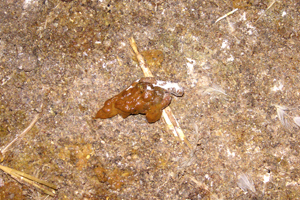Necrotic enteritis kills birds and profits

Necrotic enteritis is a common but financially the most devastating bacterial disease in broiler flocks. It is caused by Clostridium ?perfringens, a gram-positive anaerobic ?bacterium that can be found in soil, litter, dust and at low levels in the intestine of healthy birds. Preventive treatments help to diminish the impact of the disease.
By Wiebe van der Sluis
Necrotic enteritis (NE) is a complex and multi-factorial disease with many unknown factors influencing its occurrence. Sporadic outbreaks of NE can occur frequently at farms where antibiotics are not used as growth promoters or coccidial infections are not controlled, the husbandry practice is not strict, and diets are based on viscous grains with animal protein sources.
The disease primarily affects broiler chickens (2-5 wk old) and turkeys (7-12 wk old) raised on litter but can also affect commercial layer pullets raised in cages. Most often the only sign of necrotic enteritis in a flock is a sudden increase in mortality. However, birds with depression, ruffled feathers, and diarrhoea may also be seen. A depression of growth rate and feed
efficiency of birds becomes noticeable by day 35 because of damage to the intestine and the subsequent reduction in digestion and absorption of food. The gross lesions are primarily found in the small intestine (jejunum), which may be swollen, friable, and contain a stinking, brown fluid. The disease persists in a broiler flock for 5-10 days, and mortality can go up to 50%.
An ever present bacterium
Necrotic enteritis is caused by the gram-positive, obligate, anaerobic
bacteria Clostridium perfringens. There are five types of C. perfringens (A, B, C, D and E) which produce a number of toxins (alpha, beta, epsilon, iota and CPE). α-toxin, an enzyme (phospholipase C), is believed to be key in the occurrence of NE.
However, a recent study has shown that an isolate that does not produce α-toxin can still cause disease.
C perfringens is an ever-present bacteria readily found in soil, dust, faeces, feed, and used poultry litter. It is also a normal inhabitant of the intestines of healthy chickens. The enterotoxemia that results in clinical disease most often occurs either following an alteration in the intestinal microflora or from a condition that results in damage to the intestinal mucosa (eg, coccidiosis, mycotoxicosis, salmonellosis, ascarid larvae). High dietary levels of animal by-products (eg, fishmeal), wheat,
barley, oats, or rye predispose birds to the disease. These grains contain a high level of indigestible soluble fibre, which increases digesta viscosity, decreases digesta passage rate and reduces nutrient digestibility. A highly viscous intestinal environment will increase the proliferation of facultative anaerobes like gram-positive cocci and enterobacteria.
Managing necrotic enteritis
The occurrence of NE is often associated with an outbreak of coccidial infection. Coccidial infections cause damage to the intestinal lining, making the gut susceptible to other infections including C. perfringens.
The addition of anticoccidial compounds, especially of the ionophore class, has been extremely helpful in preventing the coccidial damage that leads to necrotic enteritis. Administration of probiotics or competitive exclusion cultures have been used to both prevent and treat clinical necrotic enteritis (presumably by preventing the proliferation of C. perfringens ).
Outbreaks of NE can be effectively prevented by including antibiotics such as bacitracin and avilamycin in the feed. If antibiotics are not used in the feed, strict on-farm hygiene management practice, good climate control of the buildings and careful selection of feed ingredients for diet formulation are all important in maintaining production efficiency. In Europe where antibiotics have been removed from feed, ionophorous anticoccidials have been used to manage NE.
Continued research
Following the ground-breaking
discovery that alpha-toxin is not the main causative factor for NE by the Australian PhD student Anthony Keyburn, researchers from CSIRO Livestock Industries’ Australian Animal Health Laboratory have patented NetB, the toxin they believe is the culprit. The research team has identified the novel toxin and is now working on how it might be used to create the first truly effective vaccines against NE.
Meanwhile, Dr Robert Swick of the University of New England, NSW, Australia looked at how effective Actigen is for controlling NE. He shared his findings with colleague researchers at the International Poultry Scientific Forum, held prior to the International Poultry Exposition in Atlanta. Dr Swick said that this yeast based product was as effective as
zinc bacitracin (ZB) and salinomycin in preventing performance decline from coccidiosis.
Sara Johnston of Amlan International, Vernon Hills, IL, USA studied the effects of necrotic enteritis( NE) and aflatoxin (AFL) on growth performance, lesion scores, and mortality in young broilers by testing products to alleviate them. Instead of using traditional antibiotics she gave clay-based products to birds that were challenged with NE and NE + AFL B1. As to be expected the combination of NE and AFL showed an increased negative response but adding a proprietary clay to the feed improved, compared to the non challenged birds, feed intake and gain. Adding a second proprietary clay-based product even showed improvements equal to those birds treated with virginiamycin. In her conclusion Johnston expressed that feeding clay-based products especially improved performance during a NE + AFL challenge.
In a second presentation at the International Poultry Scientific Forum Johnston said that providing virginiamycin improves feed conversion and gain up to a certain level, but also unexpectedly increased lesion scores in challenged but not unchallenged birds. She also mentioned a clear interaction between aflatoxin and necrotic enteritis resulting in decreased broiler performance. Here virginiamycin only helps to improve gain when birds are challenged at 0.75 ppm AFL but not at
1.5 ppm AFL.
These and many other research projects clearly show the complexity of necrotic enteritis and the importance of good farm management and high
quality feed.













